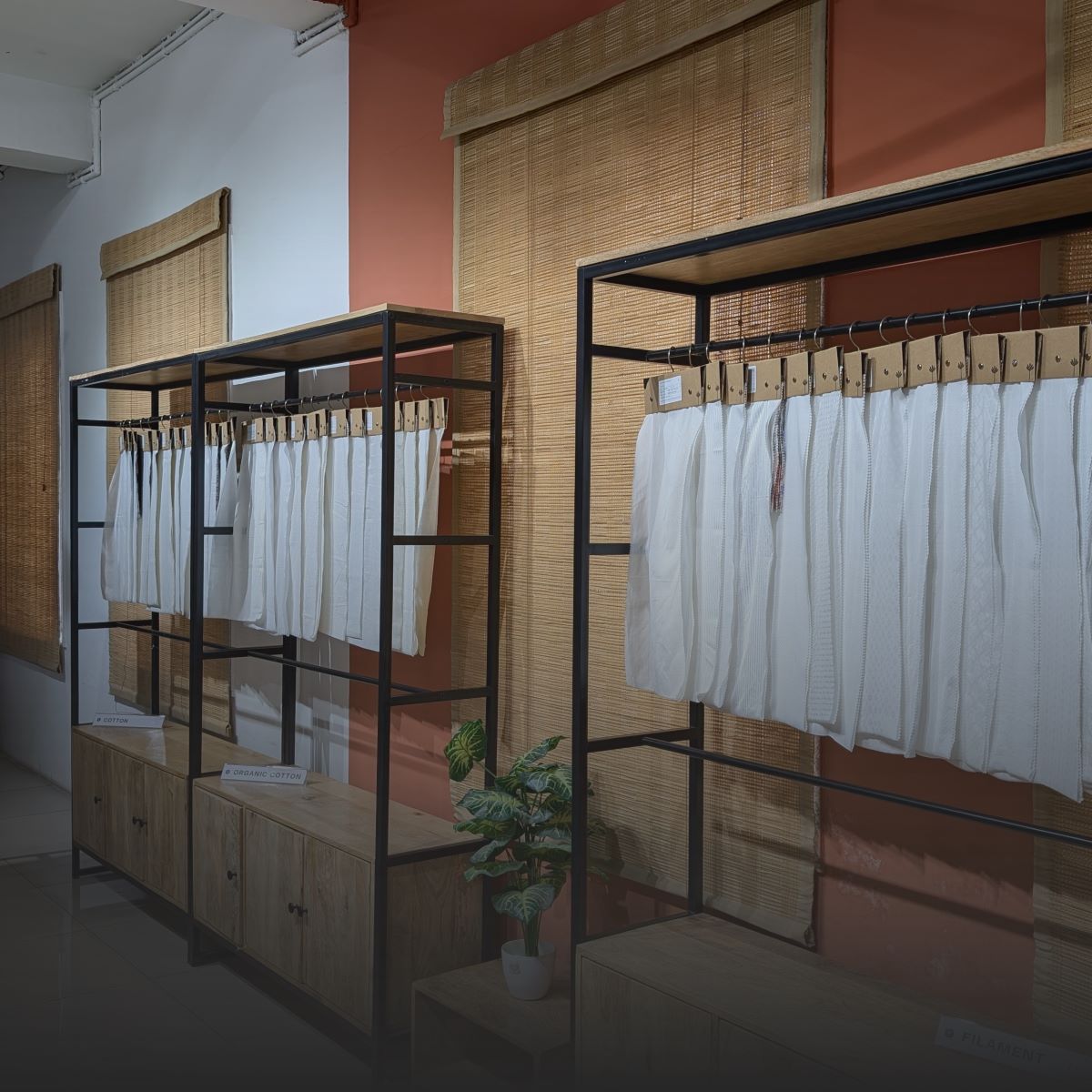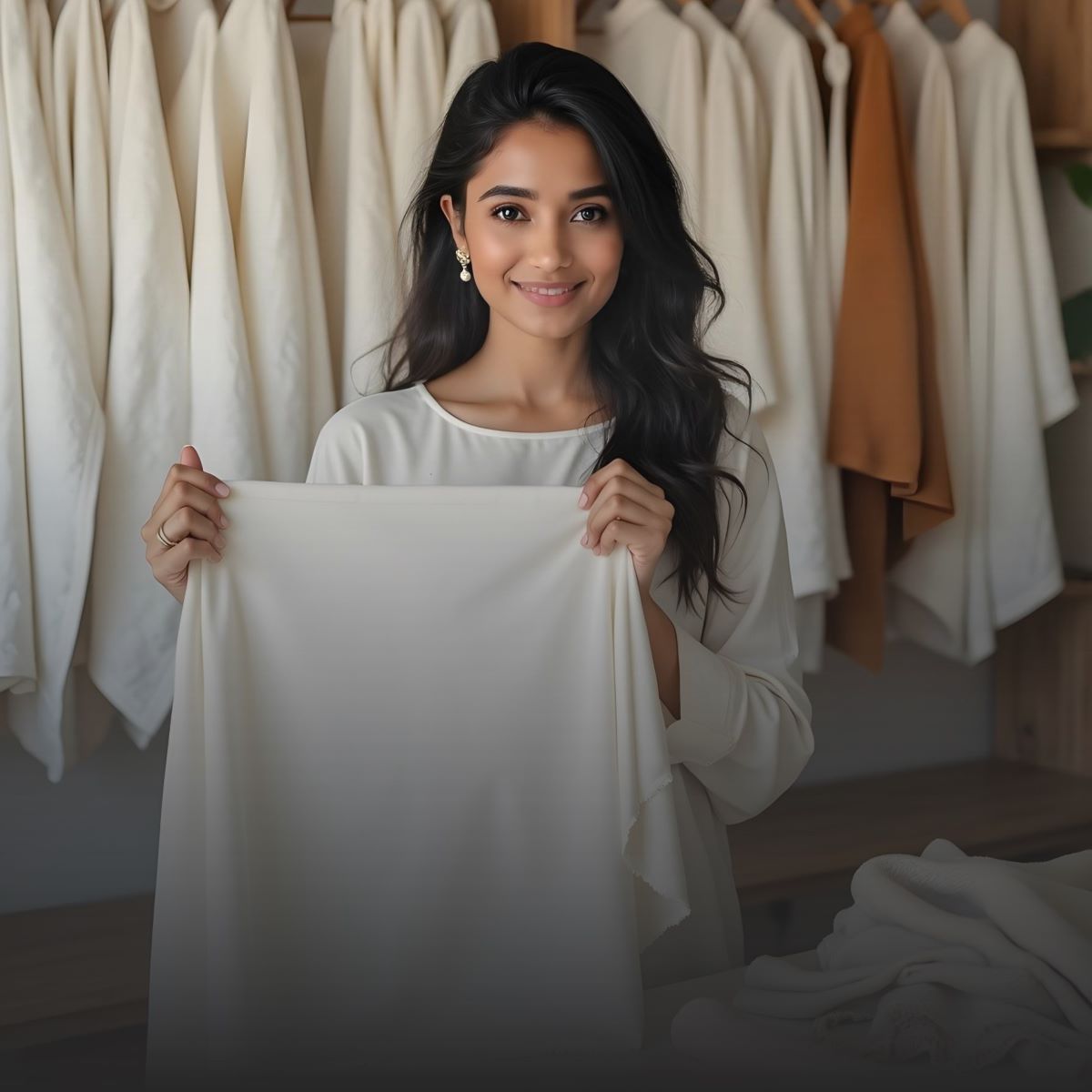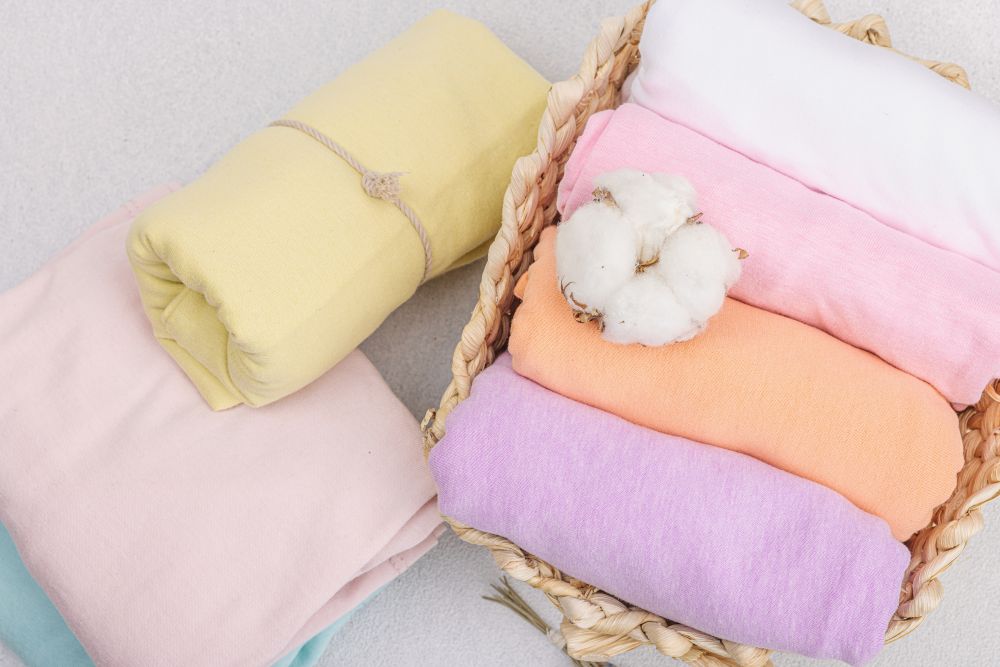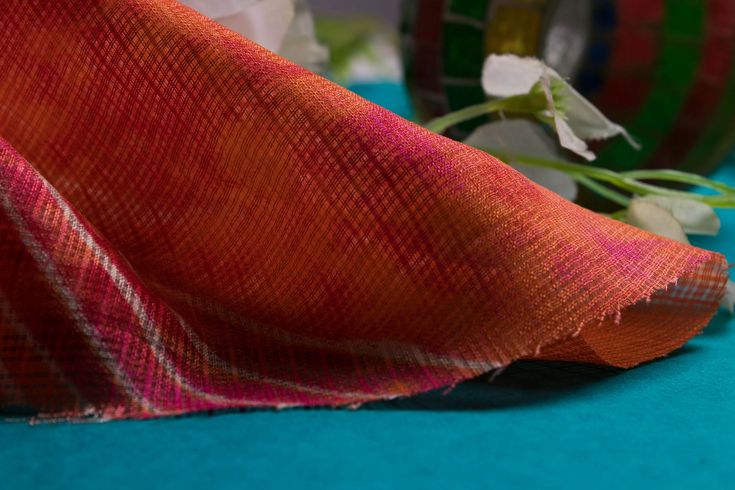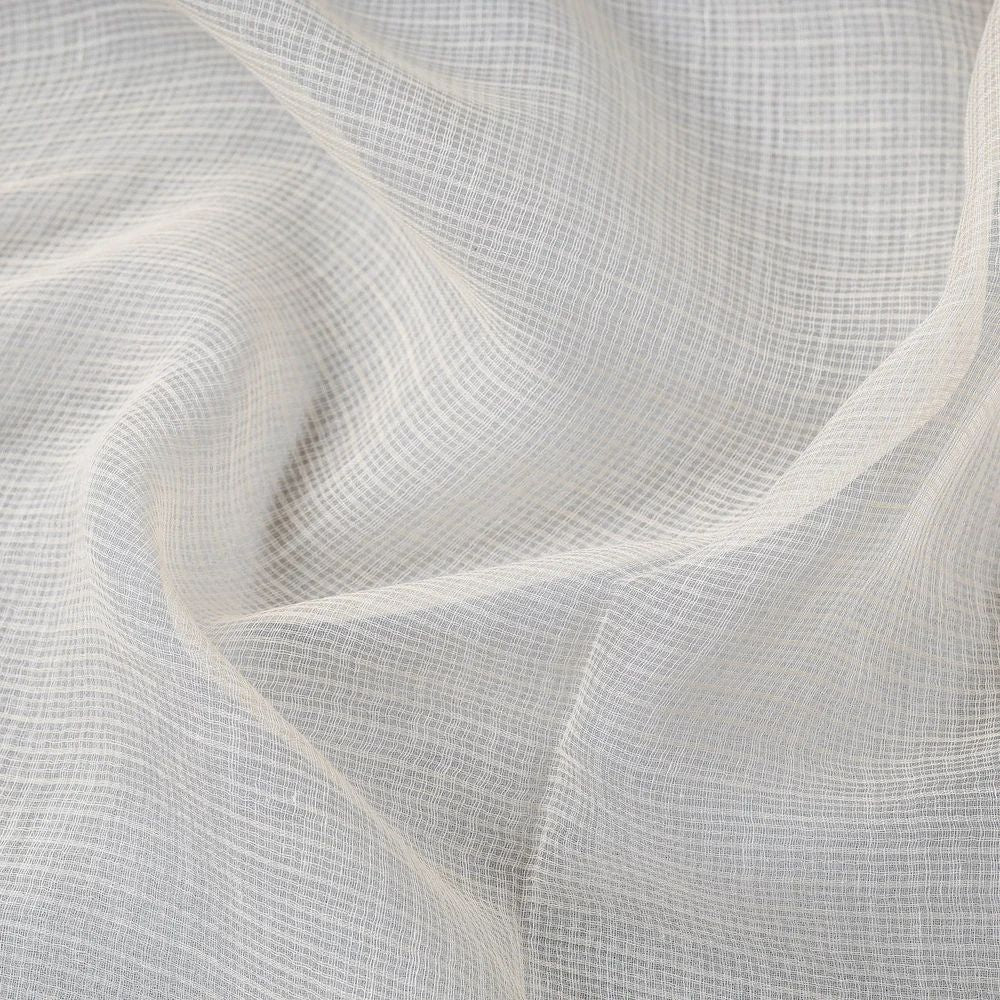If you've been looking for 50 metres of solid colour cotton flex fabric, you're already halfway to finding what you need. Most mills start dyeing at 100 metres per colour, which is the right point for cost, quality of finish, and consistency of shade.
With Fabriclore's cotton flex fabric collection, you can now get eco-dyed, solid colour fabrics in more than 95 curated shades for as little as 100 m per shade. These fabrics can be used for both home and clothing textiles.
This guide will explain why 100 m is the practical starting lot, how to test and approve swatches, and why Fabriclore is one of the world's most dependable sources for dyed cotton flex fabric.
What Exactly Is Cotton Flex Fabric?
There is a smart new fabric called cotton flex fabric that combines the softness of cotton with the structure of linen. The fabric has a natural feel, drapes beautifully, and has a slightly textured surface that gives clothes and rooms an earthy, handmade look.
Key Characteristics
- Comfort from nature: Very breathable, so it's great for places that are warm and muggy.
- Light to medium: Usually between 180 and 250 GSM, which is great for shirts, pants, and matching sets.
- Finish with texture: It looks like linen and feels smoother because it is made of slub yarns.
- Eco-friendly: Dye that doesn't harm the environment, biodegradable, and long-lasting.
- Uses both ways: Fits clothes, furniture, curtains, tablecloths, and other items.
Textile designers who care about the environment, small brands, and people who make home goods all use cotton flex because it is both soft and strong.
Why From 100 Meters Is the Industry Standard
It's easier for many small brands to start with 30–50 million requests.
In reality, professional dyeing and finishing units need a certain amount of material to get the same results every time.
Here's why 100 m makes technical and business sense:
- Uniform Dyeing: The minimum load for mill dye vats is set at 100 m, which ensures that the colour goes through evenly and there is no shade variation.
- Colour Fastness: To avoid tonal streaks, larger batches keep the pH and temperature stable.
- Economical Rate: Once you get past 100 metres, processing costs per metre drop by a lot.
- Predictable Production: Fewer joins, inspection of the whole roll at all times, and a better finish.
If you increase your MOQ from 50 m to 100 m, you won't spend more, but you will get export-grade quality and consistent colours that can be used for clothes or home decor.
Explore 95 + Solid Colour Options for Cotton Flex
At Fabriclore, OEKO-TEX®-approved dyes are used to mill-dye solid cotton flex fabrics.
Each colour is checked for wash and light fastness to make sure the colour stays true even after many washes.
Popular Colour Families
|
Palette |
Shades |
Ideal For |
|
Naturals & Neutrals |
Ivory, Sand, Beige, Ecru |
Resort wear, Minimal interiors |
|
Earthy Tones |
Olive, Terracotta, Ochre, Rust |
Jackets, Table linens, Upholstery |
|
Cool Hues |
Sky Blue, Teal, Mint, Aqua |
Shirts, Summer co-ords |
|
Warm Shades |
Coral, Maroon, Mustard, Clay |
Evening sets, Drapes |
|
Classic Solids |
Black, Navy, White, Charcoal |
Basics, Uniforms, Tailoring |
Each lot is reactive-dyed to give it a deep colour that lasts, and it is soft-finished to give it a natural fall.
👉 Explore the collection: Fabriclore Flex Cotton Collection

Applications Across Fashion & Home
Cotton flex is a link between fashion and lifestyle design. This is how you use it:
1. Apparel & Co-ord Sets
Lightweight and breathable, ideal for:
- Shirts and tops
- Relaxed trousers
- Jackets
- Co-ord sets and summer dresses
2. Home Textiles
Structured, medium-weight quality for:
- Curtains
- Cushion covers
- Upholstery
- Table runners & linens
It's a favourite among designers who want natural textures in modern spaces because it can keep its shape while still being soft.
Sustainable, Certified, and Safe
Fabriclore's cotton flex fabrics are made in a way that doesn't harm the environment:
- OEKO-TEX®–certified dyes (free from harmful chemicals).
- Water-efficient dyeing processes.
- Ethically sourced cotton yarns.
- Biodegradable finishing agents.
For sustainability, this makes sure that your finished products meet the needs for global compliance and consumer trust.
How to Order Cotton Flex Fabric from 100 Meters — Step by Step
Ordering cotton flex fabric from 100 meters is simple when you follow a clear process from sampling to production. Here's how to make sure that the color, quality, and delivery are always perfect:
Step 1: Define Your Fabric Specs
Decide on:
- GSM & weight range (light, medium, heavy)
- Intended use (apparel/decor)
- Colour palette or Pantone references
Step 2: Request Swatches or Lab Dips
You can go to Fabriclore and order swatches or sample yardage to:
- GSM accuracy
- Texture and weave uniformity
- Colour fastness after washing
👉 Buy fabric swatches before you order bulk fabric.
Step 3: Approve Your Shade
Pantone-matched custom dyeing is something Fabriclore does for large runs.
Approve the last lab dip before going into production.
Step 4: Confirm Order & MOQ
Check your 100 m per colour MOQ and finish your payment or purchase order.
Step 5: Production & Quality Checks
Fabriclore conducts:
- Colour fastness testing
- Shrinkage control
- Fabric Package Test (FPT) and visual inspections
Step 6: Shipping & Delivery
12 to 15 business days is the average time it takes to dye, finish, and ship.
Fabriclore ships all over the world with FedEx & DHL, and packages are safe and can be tracked in real time.

Quality Parameters to Check Before Bulk Purchase
Before you confirm your order for bulk cotton flex fabric, you need to look at some important quality factors that affect how long it will last, how true the colours are, and how well it works overall. Here is a quick list to help you make sure you check every detail before giving the go-ahead:
- Fiber Type: Confirm 100 % cotton or cotton-blend composition.
- Weave: Plain or twill — determines drape and strength.
- GSM: 120–180 GSM for apparel; 200 + GSM for upholstery.
- Finish: Washed, mercerised, or enzyme-softened.
- Colour Fastness: Test for bleed or fade after washing.
- Certifications: Prefer OEKO-TEX®, GOTS, or equivalent.
- Shrinkage: Pre-wash samples to note % change.
- Swatch Testing: Compare under daylight & indoor lighting.
Pro Tip: For future reordering, always write down your test results.
Testing Cotton Flex Fabric: Your 5-Point Checklist
|
Test |
Purpose |
|
Wash & Dry |
Check shrinkage & color hold. |
|
Drape & Wrinkle |
Understand fabric flow and stiffness. |
|
Seam Strength |
Evaluate stitching performance. |
|
Light & Shade |
Identify tone variation. |
|
Stretch & Recovery |
Assess durability and elasticity. |
Keeping track of these makes sure that the quality stays the same between production cycles.
Why Online Cotton Flex Sourcing Works Best Today
It doesn't make a difference whether it's India or Atlanta. Because it offers verified digital samples, swatch delivery, and clear shipping, online sourcing saves you time and gives you more choices.
Advantages
- Global variety: Access colours & finishes beyond local markets.
- Certifications: Instant documentation for sustainability compliance.
- Lower MOQ risk: 100 m per shade is manageable for small brands.
- End-to-end tracking: From dyeing to doorstep.
- Design freedom: Combine ready shades with custom dye orders.
The digital ecosystem at Fabriclore makes the process easy for both new designers and well-known labels.
Bulk Ordering & Pricing Insights
Pricing varies by:
- GSM & weave type.
- Colour or custom Pantone match.
- Finish (soft, crisp, washed).
General guidelines
- Mill-dyed ready shades: most economical.
- Custom Pantone colours: slightly higher (setup & lab-dip cost).
- 100 m+ per colour ensures optimal per-meter pricing.
Fabriclore gives you transparent, itemised quotations that include shipping and taxes, which helps you stick to your budget.
Behind the Scenes: Fabriclore's Quality & Inspection System
Multi-layer inspection is done on every bulk order:
- Yarn check before weaving.
- Colour lab verification for dye stability.
- Shrinkage test on each batch.
- Visual roll inspection – 20 + defect points checked.
- Third-party lab reports (Nissenken / Bureau Veritas) on request.
This makes sure that your 100-meter lot is production-ready and quality-certified when it gets there.
From Sampling to Scaling: How Designers Grow with 100 m Lots
Designers often start small but quickly grow when they can control the quality of the fabric and the shades. With 100 m lots, it's easy to go from sampling to full-scale production:
- Stage 1: Start with 2–3 shades, 100 m each, for capsule or test collections.
- Stage 2: Launch ready-to-wear lines or home collections using consistent lots.
- Stage 3: Re-order same shades confidently — mills maintain dye recipes for 6–12 months.
Fabriclore's team keeps track of your dye lot history so that when you get repeat orders, they are exactly the same as the last ones.
How Increasing MOQ Improves ROI
|
MOQ Level |
Per-Meter Cost |
Expected Shade Consistency |
Production Speed |
|
50 m |
Higher |
Variable |
Slower (custom batch) |
|
100 m |
Lower |
Uniform |
Fast (standard batch) |
|
200 m + |
Best |
Perfect |
Priority production |
It's best to have an MOQ of 100 m, which is low enough for designers but high enough for professional dye control.
What Makes Fabriclore a Reliable Cotton Flex Partner
Designers need a partner who can ensure consistency, customisation, and on-time delivery when they need to buy cotton flex fabric in bulk. Fabriclore stands out because it has clear rules, eco-friendly methods, and a customer-first mentality. This is why professionals all over the world trust it:
- Clear MOQs: Starts at 100 m per shade for dyed/printed orders.
- Custom Options: Pantone matching, finish control, pre-washing.
- Access to Swatch: Before you buy a lot, buy swatches and sample yards.
- Making things last: Dye that is AZO-free and OEKO-TEX®-approved.
- Shipping the world: 15 days to ship via FedEx and DHL.
- Help from start to finish: Dedicated wholesale team and tracking in real time.
Quality Control and Testing: 20 or more inspection points, and lab reports are optional.
Explore: Fabriclore – Cotton Flex Fabric Wholesale in Jaipur
Real Use Case: How a Brand Built Its Identity with Cotton Flex
In Bangalore, a sustainable fashion studio was looking for fabric that would let air flow for resortwear in 2025.
They asked for:
- Three solid colours (Olive, Ecru, Terracotta).
- 100 m per shade.
- Pantone approval via swatches before dyeing.
As a result? No rejects and perfect shade continuity across 40 styles.
The collection sold very well, and when they ordered it again months later, they used the same dye lot.
Cotton Flex Trends for 2025 and Beyond
As the fashion industry moves towards eco-friendliness and personalised styles, cotton flex keeps changing with new colours, finishes, and eco-friendly additions. Here are the main fashion trends that will affect the next collections:
- Eco-friendly cotton flex: Need for eco-dyed fibers that can be tracked.
- Balanced on earth: Ivory, beige, and muted greens are the main colors in Scandinavian style.
- Washes that are soft: Dresses and shirts that are casual are best.
- Digital matching to Pantone: Reproduction of brand colors that are accurate.
- Focus on circular design: Designers use extra lots to make smaller lines of accessories.
If you keep up with these trends, your brand will look modern and long-lasting.
Smart Sourcing Workflow Recap
To make the process of cotton flex sourcing easier, follow a clear, step-by-step plan that reduces risk and guarantees quality every time. For quick and easy ordering, here's a quick review:
- Choose colour & GSM.
- Request swatches & lab dips.
- Approve shade + finish.
- Confirm MOQ 100 m per color.
- Receive QC-checked rolls in ≈ 15 days.
This repeatable workflow makes sure that every order is done on time and to the right standard.

Common Mistakes (and How to Avoid Them)
Key checks should always be done before sourcing, even if the buyer is experienced. To make sure every order meets professional standards and avoids the most common mistakes, read on:
Skipping Shades: Pick up swatches before buying a lot to avoid getting the wrong shade.
Not looking at GSM: Causes problems with fit or drape.
Not Seeing Shrinkage: Test tolerance by washing samples first.
Putting the cheapest quote first: A lower cost can mean that the dye doesn't mix well.
Plan for No Re-order: For future runs, make sure you have the same dye lot.
Fabriclore's structured sourcing and QC support make it easy to avoid all mistakes.
Logistics & Delivery Snapshot
|
Stage |
Duration (Days) |
|
Swatch & Sample |
3–5 |
|
Lab Dip Approval |
2–3 |
|
Dyeing & Finishing |
7–10 |
|
QC & Packing |
2–3 |
|
Shipping (FedEx/DHL) |
3–5 |
|
Total Lead Time |
12–15 business days |
Fabriclore gives you real-time tracking information and shipping paperwork for every order.
Also Read: Cotton Flex fabric
Final Thoughts: Design Responsibly, Source Smartly
Cotton flex is a good example of modern sustainability because it is natural, can be used in many ways, and will never go out of style. From 100 meters on, you get professional dying, consistent quality, and long-term cost savings without spending extra money.
You can make reliable collections that reflect the style and values of your brand by using Fabriclore's verified processes, 95+ colors, Pantone matching, and 15-day shipping.
👉 Start Now: Buy Solid Color Cotton Flex Fabric from 100 Meters – Fabriclore Wholesale
FAQs: Buying Solid Cotton Flex Fabric Online
Q1. What Is The Moq For Solid Colour Cotton Flex Fabric?
As long as you order at least 100 metres per colour, the dyeing will be even and the shades will be controlled consistently.
Q2. Can I Buy Fabric Swatches Before Ordering Bulk?
Yes. Fabriclore has programmes called swatch and sample yardage that let you check the GSM, hand feel, and colour accuracy of a fabric before buying a lot of it.
Q3. How Long Does Shipping Take For Bulk Orders?
Orders are processed and sent out within 12 to 15 business days, which includes shipping and dying time.
Q4. Are Fabriclore's Cotton Flex Fabrics Eco-Friendly?
Of course. In every batch, they use AZO-free, OEKO-TEX®–certified dyes and eco-friendly water processes.
Q5. Can I Request A Custom Pantone Colour?
Yes. If you give Fabriclore your Pantone code, they will make a lab dip for you to approve before they dye your 100-meter lot.
We also happen to be a magnet for suggestions, and would love to catch yours….throw us yours on hello@fabriclore.com
